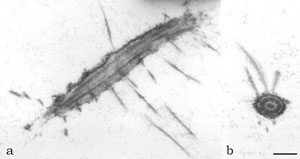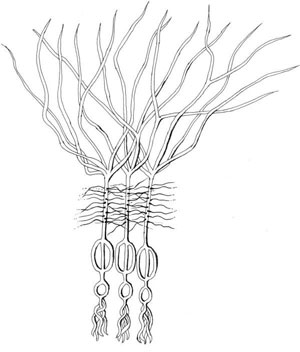Flagellar Hairs
Flagellar hairs can be grouped into two types: tubular and non-tubular (simple) hairs. Tubular hairs consist of two or more distinct regions, at least one of which is thick and tubular, while the distal elements may be simpler. This type of hairs is further divided into cryptophycean hairs, tripartite hairs, and prasinophycean hairs.
The cryptophycean hairs are unique for arrangement to the Cryptophyceae (Cryptophyta), being attached in two opposite rows on the longer flagellum, and on a single row on the shorter one. On the long flagellum the hairs consist of a tubular proximal part, 1.5–2.5 µm long, and a nontubular distal filament, 1 µm long, while the hairs on the shorter flagellum are shorter, 1–1.5 µm long, with a distal filament 1 µm long.

FIGURE 2.34 Transmission electron microscopy image of the long trailing flagellum of Ochromonas danica in both longitudinal (a) and transverse sections (b), showing the tripartite hairs. (Bar: 0.25 µm.)
Tripartite hairs are the hair type of the Heterokontophyta, (Figure 2.34a and 2.34b). These hairs consist of three morphological regions, that is, a short basal region, a tubular hollow shaft, and a distal region. The basal part is 0.2–0.3 µm long and tapers towards the site of attachment to the flagellar membrane, at which point dense structures are present that connect the hairs to the peripheral axoneme microtubules. The hollow shaft shows a range of length from 0.7–0.8 to 2 µm, and a diameter of about 16 nm. The distal parts of each hair, called terminal filaments or fibers, are extremely fragile, hence difficult to detect because readily shed during electron microscopy preparation. In some cases, they are organized in a 2+1 structure, that is, two short filaments 0.3 µm long, and one long filament 1 µm long, however, differences exist in their number, length, and diameter.

FIGURE 2.34 Transmission electron microscopy image of the long trailing flagellum of Ochromonas danica in both longitudinal (a) and transverse sections (b), showing the tripartite hairs. (Bar: 0.25 µm.)
Cells of the Prasinophyceae carry hairs on all their flagella, whether one, two, four, or eight, which are very diverse in morphology. They can vary in length from 0.5 to 3 µm, and a single flagellum may carry more than one hair type. An example is Mantoniella sp., bearing hairs on the flagellar tip which are longer than those on the side. In Pyramimonas orientalis both lateral and apical hairs are bipartite and of the same length, with the lateral hairs divided into a short, thick base of 160 nm, and a long, thin distal part of 650 nm, and the apical hairs possessing a long thick base and a very short, thin tip. In Nephroselmis and Tetraselmis there is a single hair type divided into two regions of roughly the same length (0.5 µm).
Unlike tubular hairs, simple, nontubular hairs are not differentiated into regions; they are thin and very delicate, probably consisting of a single row of subunits. These hairs occur in a variety of groups, but are unique in the two divisions of Euglenophyta and Dinophyta, whose hairy coverings share certain features not known to occur in any other algal group.

FIGURE 2.35 Short hairs of Euglena flagellum.
In Euglenophyta, long, simple hairs are arranged in a single row on the emergent part of the flagella. In genera with two emergent flagella, the hair covering is similar on the two flagella. In Euglena gracilis these long hairs consist of a single filament 3–4 µm long, with a diameter of 10 nm, while in Eutreptiella gymnastica, they are 4–5 µm long and assembled in unilateral bundles. In addition to these long hairs, euglenoid flagella carry a dense felt of shorter hairs, which in Euglena are approximately half as long and half as thick as the long hairs. These short hairs, precisely positioned with respect to each other and to axonemal components, consist of a sheath about 240–300 nm in length, which represent the basic unit. The units, each formed by loops, side arms and filaments, lie parallel to each other in the longitudinal direction of the flagellum (Figure 2.35); two groups of short hairs are arranged helically on each narrow side of the flagellum, separated from each other by two membrane areas without hair attachments. In Dinophyta, both the longitudinal and the transverse flagellum carry hairs, but unlike Euglenophyta,
the hairy coverings on the two flagella are different.

FIGURE 2.35 Short hairs of Euglena flagellum.
The transverse flagellum carries unilateral hairs except in the proximal part; they are 2–4 µm long and arranged in bundles, each bundle consisting of differently sized hairs. In Oxyrrhis marina, hairs are of three different lengths, the longest in the middle. Hairs on the longitudinal flagellum are shorter than those on the transverse flagellum (0.4–0.75 µm), but similar in diameter (10 nm). Simple, non-tubular hairs are present also in some Glaucophyta and Chlorophyta.







